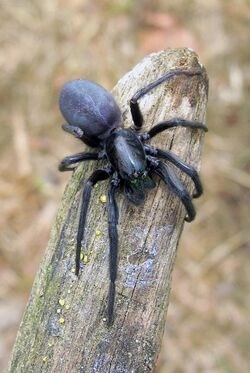Biology:Dysderoidea
| Dysderoidea | |
|---|---|

| |
| Segestria florentina (Segestriidae) | |
| Scientific classification | |
| Domain: | Eukaryota |
| Kingdom: | Animalia |
| Phylum: | Arthropoda |
| Subphylum: | Chelicerata |
| Class: | Arachnida |
| Order: | Araneae |
| Infraorder: | Araneomorphae |
| Superfamily: | Dysderoidea |
| Families[1] | |
| |
| Diversity | |
| 4 or 5 families | |
The Dysderoidea are a clade or superfamily of araneomorph spiders. The monophyly of the group, initially consisting of the four families Dysderidae, Oonopidae, Orsolobidae and Segestriidae,[2] has consistently been recovered in phylogenetic studies.[1][3] In 2014, a new family, Trogloraptoridae, was created for a recently discovered species Trogloraptor marchingtoni. It was suggested that Trogloraptoridae may be the most basal member of the Dysderoidea clade.[1][4] However, a later study found that Trogloraptoridae was placed outside the Dysderoidea and concluded that it was not part of this clade.[5]
Phylogeny
Dysderoidea are members of the Haplogynae clade: spiders with simpler copulatory organs (palpal bulbs and epigynes) than other araneomorphs. One hypothesis for relationships within the Haplogynae is shown below.[6] The status of the Trogloraptoridae is unclear. The family was not included in one study which otherwise found the same topography,[7] but it was placed outside even the Filistatidae in a 2014 study based on ribosomal DNA.[5]
| Haplogynae |
| ||||||||||||||||||||||||||||||||||||||||||||||||||||||
Other studies have suggested that Caponiidae rather than Tetrablemmidae are the sister of Dysderoidea.[8]
References
- ↑ 1.0 1.1 1.2 Michalik, Peter; Ramírez, Martín J. (2014), "Evolutionary morphology of the male reproductive system, spermatozoa and seminal fluid of spiders (Araneae, Arachnida)–Current knowledge and future directions", Arthropod Structure & Development 43 (4): 291–322, doi:10.1016/j.asd.2014.05.005, PMID 24907603
- ↑ Forster, R.R.; Platnick, N.I. (1985), "A review of the austral spider family Orsolobidae (Arachnida, Araneae) with notes on the superfamily Dysderoidea", Bulletin of the American Museum of Natural History (181)
- ↑ Coddington, Jonathan A.; Levi, Herbert W. (1991), "Systematics and evolution of spiders (Araneae)", Annual Review of Ecology and Systematics 22: 565–592, doi:10.1146/annurev.es.22.110191.003025
- ↑ Griswold, C.; Audisio, T.; Ledford, J. (2012), "An extraordinary new family of spiders from caves in the Pacific Northwest (Araneae, Trogloraptoridae, new family)", ZooKeys (215): 77–102, doi:10.3897/zookeys.215.3547, PMID 22936872
- ↑ 5.0 5.1 de Busschere, Charlotte; Fannes, Wouter; Henrard, Arnaud; Gaublomme, Eva; Jocqué, Rudy; Baert, Léon (2014), "Unravelling the goblin spiders puzzle: rDNA phylogeny of the family Oonopidae (Araneae)", Arthropod Systematics & Phylogeny 72: 177–192, https://www.researchgate.net/publication/264083120, retrieved 2015-10-30
- ↑ Nentwig, Wolfgang, ed. (2013), "Appendix : Spider Phylogeny", Spider Ecophysiology, Springer, ISBN 978-3-642-33988-2, https://link.springer.com/content/pdf/bbm%3A978-3-642-33989-9%2F1.pdf, retrieved 2015-11-03
- ↑ Coddington, Jonathan A. (2005), "Phylogeny and classification of spiders", in Ubick, D.; Paquin, P.; Cushing, P.E. et al., Spiders of North America: an identification manual, American Arachnological Society, pp. 18–24, https://repository.si.edu/bitstream/handle/10088/4365/CoddingtonSNAPhylogeny05.pdf, retrieved 2015-09-24
- ↑ Ramírez, Martín J. (2000), "Respiratory system morphology and the phylogeny of haplogyne spiders (Araneae, Araneomorphae)", Journal of Arachnology 28 (2): 149–157, doi:10.1636/0161-8202(2000)028[0149:rsmatp2.0.co;2], https://www.biodiversitylibrary.org/part/226515
Wikidata ☰ Q54486 entry
 |

